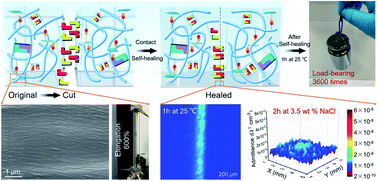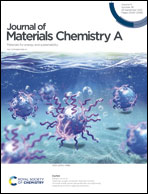Non-covalent assembly of a super-tough, highly stretchable and environmentally adaptable self-healing material inspired by nacre†
Abstract
Developing autonomous ambient temperature self-healing materials with excellent mechanical strength is extremely challenging. Herein, inspired by nacre and mussels, we utilize the T-shaped chain extender with quadruple hydrogen bonds on the side chain to extend the polyurethane (PU) prepolymer. Then by virtue of the high-density non-covalent bond interaction at the interface between the dopamine-modified graphene oxide and the PU matrix, we obtained an ultrarobust strong self-healing material. Relying on the rapid and dynamic reconstruction of side chain quadruple hydrogen bonds, the composite with an inverse artificial nacre structure and interwoven network exhibits excellent stretchability (596.2%), high ultimate tensile strength (10.3 MPa), toughness (37.8 MJ m−3), and Young's modulus (31.5 MPa), as well as unexpected ambient temperature rapid self-healing ability (90%, 25 °C for 1 h). Interestingly, graphene arranged in parallel in PU can significantly enhance the impermeability and long-term corrosion resistance of the coating. This bionic strategy provides a potential pathway to develop ultrarobust self-healing materials used in marine harsh environment equipment, various flexible functional devices and even medical materials.



 Please wait while we load your content...
Please wait while we load your content...